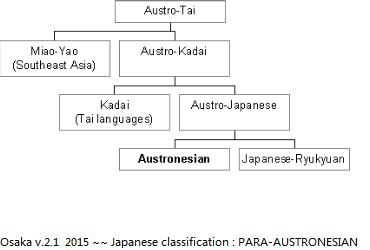Glottolog: None | ||
 | ||
Linguistic classification: proposed language family Subdivisions: AustroasiaticAustronesianHmong–MienAinuNihaliJapanese language (Japonic) | ||
Austric is a large hypothetical grouping of languages primarily spoken in Southeast Asia, the Pacific, and the eastern Indian subcontinent. It includes the Austronesian language family of Taiwan, the Malay Archipelago, Pacific Islands, and Madagascar, as well as the Austroasiatic language family of mainland Southeast Asia, Eastern India, Nepal and Bangladesh. The hypothesis of a genetic relationship between these two language families is not widely accepted among linguists.
Contents
Related proposals include Sino-Austronesian (Laurent Sagart) and Austro-Tai (Paul K. Benedict).
History
The Austric superfamily was first proposed by the German missionary Wilhelm Schmidt in 1906. He showed phonological, morphological, and lexical evidence to support the existence of an Austric superfamily, but the lexical evidence was considered to be tenuous by the larger linguistic community. Consequently, the Austric hypothesis has never gained wide acceptance. In 1942, Paul K. Benedict extended the Austric hypothesis to include the Tai–Kadai languages and the Hmong–Mien (Miao–Yao) languages.
Despite the tenuous lexical evidence, the relationship of Austronesian with either Austroasiatic or Tai–Kadai has many proponents to this day, mostly on morphological grounds. Some believe that recently discovered morphological similarities between Nicobarese and Austronesian constitute solid proof of a genetic relationship. Other researchers are still searching for the missing lexical link between Austronesian and Austroasiatic or Tai–Kadai. A good summary of the present state of the Austric hypothesis may be found in Reid 2005.
Murray Gell-Mann, Ilia Peiros, and Georgiy Starostin maintain that the Austric hypothesis is less well supported than several other linguistic macrofamilies, including Sino-Caucasian, Eurasiatic, and Afroasiatic since "no detailed proto-Austric glossaries or equally detailed tables of correspondences between the various daughter branches of Austric have been produced." An expanded Greater-Austric has been suggested to include the Ainu languages and possibly the Nihali language though this is currently not a mainstream view. In contrast to these older proposals subsumed under the label Austric, an exclusive relationship of Austronesian with the Ongan languages (but not other Andamanese languages) has been suggested (Blevins 2007). Echoing part of Benedict's version of the Austric proposal, Kosaka (2002) argued specifically for a Miao–Dai family. In 2015 Alexander Vovin recreated parts of proto-Japanese and found strikingly similarities with South-East-Asian languages that do not exist in any Altaic or North-East-Asian language.
Classification schemes
The following classification scheme, proposed by Paul K. Benedict, is the most commonly accepted one. Hmong–Mien languages are occasionally included, but are often rejected from the Austric superfamily.
Sergei Starostin, however, splits Austric into two main branches. The Austric branch would be considered to be most closely related to Dené–Caucasian, forming a Dene-Daic super-family:
